Itami, Hyōgo
Itami (Japanese: 伊丹市, romanized: Itami-shi, lit. 'Itami City') is a city located in Hyōgo Prefecture, Japan. As of May 2018, the city had an estimated population of 197,335 and a population density of 7,865/km2 (20,370/sq mi).[1][2] The total area is 25.09 km2 (9.69 sq mi).[1][2] Itami sits on the Hankyū Itami Line and the JR Takarazuka Line (also known as the Fukuchiyama Line).
Itami
伊丹市 | |||||||||||
|---|---|---|---|---|---|---|---|---|---|---|---|
 Flag  Chapter | |||||||||||
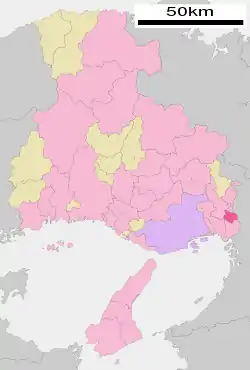 Location of Itami in Hyōgo Prefecture | |||||||||||
 Itami Location in Japan | |||||||||||
| Coordinates: 34°47′N 135°24′E[1] | |||||||||||
| Country | Japan | ||||||||||
| Region | Kansai | ||||||||||
| Prefecture | Hyōgo Prefecture | ||||||||||
| Government | |||||||||||
| • Mayor | Yasuyuki Fujiwara | ||||||||||
| Area | |||||||||||
| • Total | 25.09 km2 (9.69 sq mi) | ||||||||||
| Population (1 May 2018) | |||||||||||
| • Total | 197,335[2] | ||||||||||
| • Density | 7,865/km2 (20,370/sq mi) | ||||||||||
| Time zone | UTC+09:00 (JST) | ||||||||||
| City hall address | 1-1 Senzo, Itami-shi, Hyōgo-ken 664-8503 | ||||||||||
| Website | www | ||||||||||
| |||||||||||
History
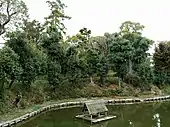
The hilly area is called the Itami plateau, between the Ina River and the Muko River in the southeastern part of Hyōgo Prefecture.[1] Rice cultivation was done in the area from ancient times.
Itama has also been called Inano because from the southern part of Itami to the northern part of Amagasaki, there are burial mounds called kofun (古墳, lit. ''ancient tomb''), such as the Gogadzuka Kofun (御願塚古墳)[4] and Kashiwagi Kofun, which were built during the Kofun period. Many waka (和歌) that wrote "Inano" can be found in the waka collection woven from the Nara period to the Heian period. Among the most famous are the waka written by Daini no Sanmi (大弐三位). In the northern part of Itami, there is a historic site of a Buddhist temple, called the Itami Ruined Temple Site, from the Nara period to the Kamakura period.
The center of Itami became a wealthy town by the middle of Sengoku period. It was named Itami-go (lit. ''town of Itami'') and known as the only Japanese town within a castle, since Japanese castles were usually located far from domestic areas. Itami-go was a part of Castle Arioka, which Araki Murashige ruled under Oda Nobunaga. After the uprising and defeat of Araki, the castle was torn down.
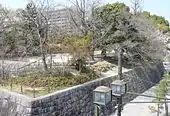
Today's city was established on 10 November 1940. Great portions of the city were damaged in the Great Hanshin–Awaji earthquake of 1995, but were quickly rebuilt.
Most of Osaka International Airport is located in Itami (hence its common name "Itami Airport"); it is Osaka's primary domestic airport, although all international flights and many domestic flights shifted to Kansai International Airport in 1994. Despite the airport's association with Itami, the terminal complex is located in the neighboring city of Toyonaka and the Itami city center is connected to the airport only by a long tunnel that passes beneath the runway and tarmac.
The city is also famous for Koyaike Park,[1] which features a large model of the Japanese archipelago set in a circular pond. The park is a frequent sight for passengers on flights into Itami Airport. Moreover, Itami is one of the important sake-brewing cities in Japan.[1] Itami City states that it was a place where sake, particularly seishu (清酒), was invented.[1]
Geography
Itami is located in the southeast of Hyōgo prefecture, with the Ina River east and the Muko River west.[1] The city area is a flat, undulating gentle terrain throughout.[1] JR West Japan JR Takarazuka Line (also known as the Fukuchiyama Line) and Hankyū Itami Line traverse north and south. It is roughly 10 km (6.2 mi) from Osaka and contacts Kawanishi in the north, Takarazuka in the northwest, Nishinomiya and Amagasaki in the southwest, and Ikeda and Toyonaka in the east.[1] In Hyōgo prefecture, the population density is the second highest following Amagasaki in the south neighbor.
Neighboring municipalities
- Hyōgo Prefecture
- Osaka Prefecture
Industry
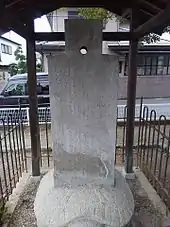
The history of sake brewing in Itami is very old, having been done since the Muromachi period. In the Itami area, a method of brewing clear and colorless Japanese rice wine, now known as sake, was discovered.[1] In the Edo period, the sake brewed in Itami was popular.[1] Sake remains a significant contributor to the local economy.[1]
Culture and regular events

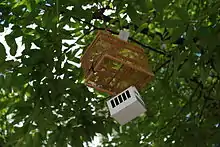
- Itami Machinakanaka Bar is an eating and drinking event in the city center of Itami. It held twice a year, in spring and autumn, and musicians can often be found performing in the streets during the event.
- Nakumushi to Go-cho (lit. ''insect hearing'') is a Japanese poetry event in autumn. In the Itami city center, the "insect hearing" event is held every September. At this event, various events related to "insect hearing" occur—such as music concerts, study sessions, reading books, and workshops—over the course of a few weeks.
Sport, leisure, and tourism


The following is a list of major landmarks in Itami:
- Inano shrine (猪名野神社)
- Koya temple(昆陽寺)
- Itami Castle Ruins (伊丹城址), also known as the Arioka Castle Ruins (有岡城址)
- Koyoike Park (昆陽池公園)
- Itami Sky Park (伊丹スカイパーク)
- Aramaki rose park (荒牧バラ公園)
- Miyamena Cultural Towns Itami-shi Itami-cho Town Pavilion, Town Old Okada Family with Sake Brewery (Important Cultural Property of the Country) (みやのまえ文化の郷)
- Kakimori Bunko (柿衞文庫),[8] which claims to be one of the three museums in the world housing major collections of haiku poetry and painting; it houses the Kakimori Collection, a poetry collection of haikai.[9]
- Itami City Library (伊丹市立図書館)
- Itami City Museum of Art (伊丹市立美術館)
- Itami City Museum of Insects (伊丹市昆虫館)
- Gogadzuka Kofun (御願塚古墳), a kofun from the Kofun period[4]
Notable people
- Uejima Onitsura (1661–1738), Japanese haiku poet of the Edo period
- Yoko Minamino (1967–), Japanese actress and singer
- Masami Okui (1968–), Japanese singer-songwriter
- Akira Ueda (1970–), Japanese video game designer and founder of Audio, Inc.
- Aiko Uemura (1979–), Japanese mogul skier
- Hiroyuki Nakajima (1982–), Japanese professional baseball player
- Katsuki Yamazaki (1982–), Japanese professional baseball player
- Masahiro Tanaka (1988–), Japanese professional baseball player
- Hayato Sakamoto (1988–), Japanese professional baseball player
- Kasumi Arimura (1993–), Japanese actress
References
- "Sake and Itami". Itami City. Archived from the original on 12 May 2018. Retrieved 12 May 2018.
- "伊丹市の統計" [Statistics of Itami City] (in Japanese). Itami City. 1 May 2018. Archived from the original on 12 May 2018. Retrieved 12 May 2018.
- "伊丹市マスコットキャラクター「たみまる」の紹介" [Introduction of Itami City mascot character "Tamimaru"] (in Japanese). Itami City. Archived from the original on 12 May 2018. Retrieved 12 May 2018.
たみまるの特徴・設定[:] カモ科の水鳥「マガモ」の雄がモチーフ。 [Characteristics and setting of Tamimaru: The motif of the male of the water bird 'Mallard' of the duck family.]
- "御願塚古墳(ごがづかこふん)" [Gogadzuka Kofun (Go-ga-dzuka Ko-fun)] (in Japanese). Itami City. Archived from the original on 12 May 2018. Retrieved 12 May 2018.
- "ウリハッキョ一覧" (Archive). Chongryon. Retrieved on October 14, 2015.
- "TID Travel Journal "Itami City: Dream and Fascination"". Hyogo Tourism Association. Retrieved April 2, 2015.
- Dr. Katsuhiro Sasuga (28 October 2004). Microregionalism and Governance in East Asia. Routledge. p. 144. ISBN 0-415-33134-X.
- "Kakimori Bunko" (in English and Japanese). Itami City. Archived from the original on 12 May 2018. Retrieved 12 May 2018."The Public Interest Incorporated Foundation, Kakimori Bunko". Itami City. Archived from the original on 12 May 2018. Retrieved 12 May 2018.
- "Kakimori Bunko – haiku poetry and painting collection". Kakimori Bunko. Archived from the original on 12 May 2018. Retrieved 12 May 2018.
Kakimori* Bunko is a museum-library for the Kakimori Collection, one of the world's three** major collections of haiku poetry and painting. It was founded in November 1984. The collection itself was assembled by the late Professor Rihei Okada (1892–1982), an honorary citizen of Itami and authority on Japanese classical literature.
External links
| Wikimedia Commons has media related to Itami, Hyogo. |